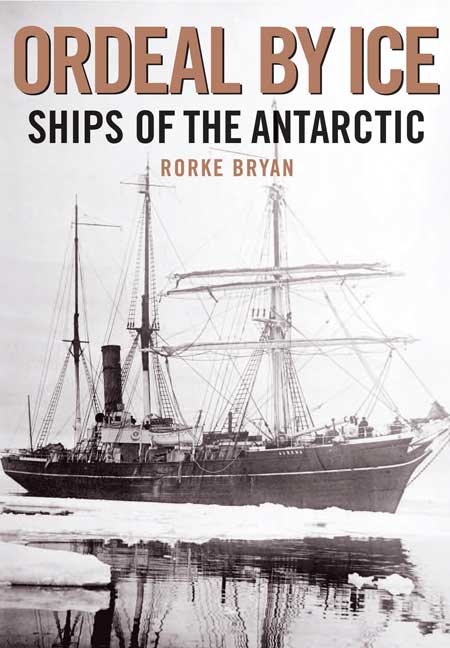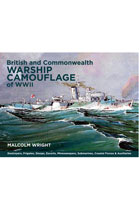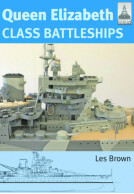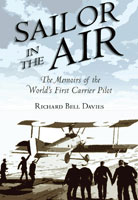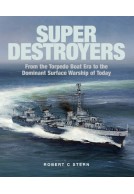Ordeal By Ice (Hardback)
Ships of the Antarctic
(click here for international delivery rates)
Order within the next 6 hours, 8 minutes to get your order processed the next working day!
Need a currency converter? Check XE.com for live rates
Surrounded by hazardous seas and pitiless ice, Antarctica was first sighted by Europeans less than three centuries ago. Since then, hundreds of ships have voyaged around that continent, challenged by poorly charted waters, storms, pack ice, icebergs and disease. This comprehensive and richly illustrated book tells the story of these ships and the expeditions they supported, from the fifteenth-century fleets of the Ming Emperors of China to today's tourist ships and powerful icebrakers.
From extensive research, the author draws all these stories into one comprehensive record. Familiar names such as Terra Nova and Endurance feature with unfamiliar but equally important ships, while tales of heroic seamanship, like Captain John Briscoe's extraordinary 1830-32 circumnavigation in the tiny Tula, or Shackleton's voyage in the James Caird, illustrate the horrendous conditions that sailors and explorers faced. Plans, photos, paintings and maps enhance a highly authoritative and readable text that will appeal to polar historians, adventurers, armchair travellers, ship enthusiasts and visitors to Antarctica.
It will fill an important gap in polar literature and is destined to become the reference book on the ships of the Antarctic as well as a superb and concise history of Antarctic exploration.
On the one hand we have an interesting collection of 96 black and white photographs, some of them with a truly spectacular double page, and on the other, an instructive collection of 93 color images, composed of many planes, diagrams, drawings, maps and also some photographs.
José Manuél Rico Cortés (Mister JM) - Miniaturas JM
It seems to me an essential book that should be kept in every library on naval subjects of its own.
Read the full Spanish review here.
A comprehensive and academic reference book for those scholars searching for detailed specifications of Antarctic vessels.
Society for the History of Discoveries
Rorke Bryan succeeds admirably in filling this important gap in Antarctic History. Although the focus of his text remains firmly on the design and history of the ships, Bryan provides such a thorough examination of the aims, progress and achievements of each expedition that he effectively writes a history of Antarctic exploration comparable with any of the best. While most histories linger excessively on the heroic age, Bryan refreshingly gives equal weight to many lesser-known and somewhat less sensational voyages that came after: the commercial whaling fleets, those that established territorial claims, and the scientific research vessels of the later twentieth century. Throughout his work he places particular emphasis on the financing of expeditions, that all-important factor which decided whether a vessel would be plucked from obscurity to server as best as it could in conditions for which it never intended, or whether the ship serve as best as it could in the conditions for which it was never intended, or whether the ship would be purpose-built fir the extremes to encounter. Bryan's text is delivered without padding and unnecessary verbiage; every cryptic sentence conveys an essential statement of fact. The book remains eminently readable, both for the general reader and specialists alike. It is most attractively presented - lavishly illustrated with hundreds if highly detailed deck plans, cross-sections, profiles, elevations, and rigging diagrams, many of them the original architects plans unearthed from the archives and made accessible for the first time. Bryan complements these wherever possible with paintings, photographs and line drawings of the vessels, together with the illustrations of definitive models and reconstructions found in museums and private collections. At a price that will suit even the most shallow of pockets, Bryan's book provides a rare combination of appeal to the casual reader and exacting detail for the specialist. Unique in the field it embraces, it is an essential addition to any library of maritime history.
International Journal of Maritime History
This comprehensive and richly illustrated book tells the story of these ships and the expeditions they supported, from the 15th century fleets of the Ming Emperors of China to today's tourist ships and powerful icebreakers. From extensive research, the author draws all these stories into one extensive record. Plans, photographs, paintings and charts enhance a highly authoritative abd readable text.
World Ship Review
iIndividual expeditions, ships, and explorers have been covered in have been covered in detail before by others but Bryan weaves together many strands of the complex story of how advances in shipbuilding (the actual hardware), seamanship (navigation, cartography) and even ancillary developments such as food preservation, medicines, or communications relate to the exploration of an environment that even today remains largely uncharted. Anyone with an imagination will find the almost incomprehensibly difficult early parts of this chapter of human endeavor moving. Whenever you feel you have a tough day, just pick up this book and read and random page.
Speedreaders.info
Quite simply, wonderful. It is beautifully presented , lavishly illustrated and, above all, thoroughly researched. Very successfully, Rorke Bryan presents a convincing and compelling story of polar exploration and its ships.
James Caird Society Journal
'Ordeal by Ice' is a monumental achievement in its own right that represents the culmination of an historical odyssey spanning half a century.
Eastern Daily Press
This is an outstanding book and I would very highly recommend it to our readers.
Shipping Today and Yesterday
A fascinating and very informative book...highly recommended.
Model Boats
This book serves as a fitting tribute to the seafarers who braved almost indescribable cold, mountainous waves and navigational perils to nurse their ships through some of the most inhospitable waters in the world.
Nautilusint Telegraph
This encyclopaedic 536-page work begins with theories about the very earliest expeditions into the area- made possible by dramatic advances in navigation and ship construction techniques that owed much to the Chinese.
The book explains how the explorations these vessels supported helped to advance knowledge about astronomy, botany, biology and science.







